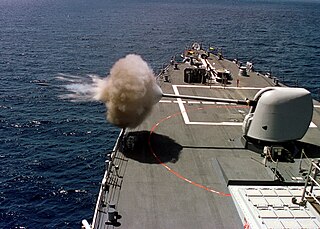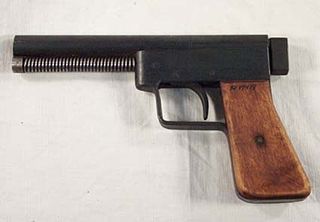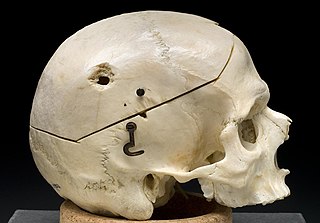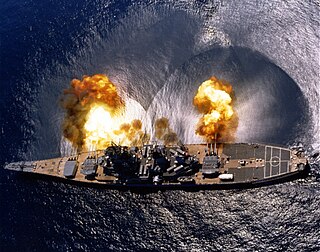See also
- Gunshot wound
- Gunshot residue (GSR), also known as cartridge discharge residue (CDR), or firearm discharge residue (FDR)
- Gunshot suicide
A gunshot is the discharge of a firearm, producing a mechanical sound effect and a chemical gunshot residue.
Gunshot or gun shot may also refer to:
FDR, or Franklin D. Roosevelt (1882–1945), was president of the United States from 1933 to 1945.

A firearm is any type of gun designed to be readily carried and used by an individual. The term is legally defined further in different countries.

Gun safety is the study and practice of using, transporting, storing and disposing of firearms and ammunition, including the training of gun users, the design of weapons, and formal and informal regulation of gun production, distribution, and usage, for the purpose of avoiding unintentional injury, illness, or death. This includes mishaps like accidental discharge, negligent discharge, and firearm malfunctions, as well as secondary risks like hearing loss, lead poisoning from bullets, and pollution from other hazardous materials in propellants and cartridges. There were 47,000 unintentional firearm deaths worldwide in 2013.
Shot may refer to:

A gunshot is a single discharge of a gun, typically a man-portable firearm, producing a visible flash, a powerful and loud shockwave and often chemical gunshot residue. The term can also refer to a ballistic wound caused by such a discharge.

A blank is a firearm cartridge that, when fired, does not shoot a projectile like a bullet or pellet, but generates a muzzle flash and an explosive sound like a normal gunshot would. Firearms may need to be modified to allow a blank to cycle the action, and the shooter experiences less recoil with a blank than with a live round. Blanks are often used in prop guns for shooting simulations that have no need for ballistic results, but still demand light and sound effects, such as in historical reenactments, special effects for theatre, movie and television productions, combat training, for signaling, and cowboy mounted shooting. Specialised blank cartridges are also used for their propellant force in fields as varied as construction, shooting sports, and fishing and general recreation.
Double action refers to one of two systems in firearms where the trigger both cocks and releases the hammer.
Gun fu, a portmanteau of gun and kung fu, is a style of sophisticated close-quarters gunfight resembling a martial arts battle that combines firearms with hand-to-hand combat and traditional melee weapons in an approximately 50/50 ratio. It can be seen in Hong Kong action cinema, and in American action films influenced by it.
Barry Michael George is an Englishman who was found guilty of the murder of English television presenter Jill Dando and whose conviction was overturned on appeal.

Gunshot residue (GSR), also known as cartridge discharge residue (CDR), gunfire residue (GFR), or firearm discharge residue (FDR), consists of all of the particles that are expelled from the muzzle of a gun following the discharge of a bullet. It is principally composed of burnt and unburnt particles from the explosive primer, the propellant (gunpowder), and vaporized lead. The act of firing a bullet incites a very violent explosive reaction that is contained within the barrel of the gun, which can cause the bullet, the barrel, or the cartridge to become chipped. Meaning gunshot residue may also included metal fragments from the cartridge casing, the bullets jacket, as well as any other dirt or residue contained within the barrel that could have become dislodged.
Misfire may refer to:

A contact shot is a gunshot wound incurred while the muzzle of the firearm is in direct contact with the body at the moment of discharge. Contact shots are often the result of close-range gunfights, suicide, or execution.

A blank-firing adapter or blank-firing attachment (BFA), sometimes called a blank adapter or blank attachment, is a device used in conjunction with blank ammunition for safety reasons, functional reasons or a combination of them both. Blank firing adapters are required for allowing blank ammunition to cycle the bolts of most semi-automatic and automatic firearms. It can also be a safety feature designed to break up the plugs replacing the bullet in military blanks as well as divert the hot gases from a blank discharge out to the sides, reducing the risk of injury to the target of an aimed shot.

Improvised firearms are firearms manufactured other than by a firearms manufacturer or a gunsmith, and are typically constructed by adapting existing materials to the purpose. They range in quality from crude weapons that are as much a danger to the user as the target to high-quality arms produced by cottage industries using salvaged and repurposed materials.

A gunshot wound (GSW) is a penetrating injury caused by a projectile from a gun. Damages may include bleeding, bone fractures, organ damage, wound infection, loss of the ability to move part of the body and, in more severe cases, death. Damage depends on the part of the body hit, the path the bullet follows through the body, and the type and speed of the bullet. Long-term complications can include bowel obstruction, failure to thrive, neurogenic bladder and paralysis, recurrent cardiorespiratory distress and pneumothorax, hypoxic brain injury leading to early dementia, amputations, chronic pain and pain with light touch (hyperalgesia), deep venous thrombosis with pulmonary embolus, limb swelling and debility, lead poisoning, and post-traumatic stress disorder (PTSD).

A muzzle blast is an explosive shockwave created at the muzzle of a firearm during shooting. Before a projectile leaves the gun barrel, it obturates the bore and "plugs up" the pressurized gaseous products of the propellant combustion behind it, essentially containing the gases within a closed system as a neutral element in the overall momentum of the system's physics. However, when the projectile exits the barrel, this functional seal is removed and the highly energetic bore gases are suddenly free to exit the muzzle and rapidly expand in the form of a supersonic shockwave, thus creating the muzzle blast.
The following are terms related to firearms and ammunition topics.

In firearms, a safety or safety catch is a mechanism used to help prevent the accidental discharge of a firearm, helping to ensure safer handling.

A silencer, also known as a sound suppressor, suppressor, or sound moderator, is a muzzle device that reduces the acoustic intensity of the muzzle report and muzzle rise when a gun is discharged, by modulating the speed and pressure of the propellant gas from the muzzle and hence suppressing the muzzle blast. Like other muzzle devices, a silencer can be a detachable accessory mounted to the muzzle, or an integral part of the barrel.
An unintentional discharge is the event of a firearm discharging (firing) at a time not intended by the user. An unintended discharge may be produced by an incompatibility between firearm design and usage, such as the phenomenon of cooking off a round in a closed bolt machine gun, a mechanical malfunction as in the case of slamfire in an automatic weapon, or be user induced due to training issues or negligence. The phenomenon has also been defined in scientific literature as an activation of the trigger mechanism that results in an unplanned discharge that is outside of the firearm’s prescribed use. Where prescribed use refers to departmental policies and laws related to the operation of firearms.